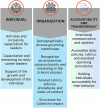Leveraging collective impact to characterize and identify solutions to cultural challenges within scientific societies
- PMID: 40060163
- PMCID: PMC11884808
- DOI: 10.1093/biosci/biae114
Leveraging collective impact to characterize and identify solutions to cultural challenges within scientific societies
Abstract
A consortium of scientific societies recently identified challenges to inclusivity within the biology communities they represent. Specifically, societies encounter difficulties collecting member demographic data effectively, integrating scientists at transitional career stages, and diversifying their leadership. In response, the Leveraging, Enhancing, and Developing Biology (LED-BIO) research coordination network (NSF 2134725) organized two meetings at the Marine Biological Laboratory in Woods Hole, MA to gather stakeholders and employ top-down and bottom-up organizational approaches to address these challenges. These meetings included Town Hall and Think Tank events to facilitate open dialogue and gather feedback on policies and programs from national organizations in attendance. These discussions provided valuable insights into the barriers societies face and the available resources and interventions societies use to promote inclusivity. This article uses the LED-BIO research coordination network as a case study to discuss the Town Hall-Think Tank-Consensus Building (TTC) methodology for advancing inclusive excellence in scientific communities.
Keywords: career transitions; culture change; demographic data collection; inclusive leadership; scientific societies.
© The Author(s) 2024. Published by Oxford University Press on behalf of the American Institute of Biological Sciences.
Figures





References
-
- [AAAS] American Association for the Advancement of Science . 2020. Baseline Assessment of Demographic Representation in AAAS/Science Functions. https://www.aaas.org/sites/default/files/2020-10/Baseline%20Assessment%2...
-
- [AAAS] American Association for the Advancement of Science . 2024. AAAS 2017 Annual Meeting: Moderator Guidance. AAAS. https://meetings.aaas.org/wp-content/uploads/Moderator-Guidance.pdf
-
- Aguilar L. 2006. Ouch! That Stereotype Hurts: Communicating Respectfully in a Diverse World. The Walk The Talk Company.
-
- Batchelor RL, Ali H, Gardner-Vandy KG, Gold AU, MacKinnon JA, Asher PM. 2021. Reimagining STEM workforce development as a braided river. Eos 102: 10.1029.
LinkOut - more resources
Full Text Sources

